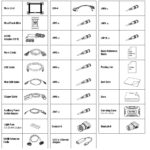VCDS (VAG-COM Diagnostic System) is a powerful software tool used for diagnosing and troubleshooting issues in Volkswagen, Audi, Seat, and Skoda vehicles. This guide provides a detailed walkthrough of the VCDS software interface and its various functions, offering a comprehensive “Vcds инструкция” (instruction manual) for users.
This guide is based on screenshots from the latest version of VCDS running on Windows 10. While your operating system might display the interface differently, the core functionality remains consistent across platforms. Before diving into specific functions, ensure you have tested and saved your port settings in the Options screen.
Navigating the VCDS Main Screen
Upon launching VCDS, you’ll encounter the main screen presenting eight key functionalities:
- Select: This button allows you to manually choose the specific control module you want to diagnose.
- Auto-Scan: Initiates an automatic scan of all available control modules in your vehicle.
- SRI Reset: Performs a Service Reminder Indicator reset.
- OBD-II: Accesses generic OBD-II functions for emissions-related diagnostics.
- Applications: Provides access to various manufacturer-specific applications and utilities.
- Options: Allows you to configure VCDS settings, including port selection and communication parameters. Crucially, port settings must be tested and saved here before most other functions become available.
- About: Displays information about the VCDS software version and license.
- Exit: Closes the VCDS program.
Each button can be activated by clicking with your mouse or navigating using the Tab key and selecting with the Enter key. Note that until your port settings are configured correctly, most buttons will appear grayed out.
Exploring VCDS Functions: A Detailed VCDS инструкция
Beyond the main screen, VCDS offers a wealth of diagnostic and troubleshooting capabilities. Key functions include:
- Fault Codes (02 – DTCs): Read, clear, and interpret diagnostic trouble codes stored in various control modules. This helps pinpoint the root cause of malfunctions.
- Measuring Blocks (08): Monitor live data streams from various sensors and actuators in real-time, providing insights into system performance.
- Output Tests (03): Activate specific components like relays, actuators, and valves to test their functionality.
- Coding (07): Modify control module coding to customize vehicle features or address specific issues.
- Adaptation (10): Adjust various parameters within control modules to fine-tune system behavior.
- Security Access (16): Access security-protected functions within certain control modules.
- Basic Settings (04): Perform guided procedures for calibrating and resetting specific systems.
These functions, along with others like Single Reading, Supported Codes, Readiness, and Advanced ID, provide a comprehensive toolkit for diagnosing and repairing VAG vehicles. Each function offers specific data and options depending on the chosen control module.
Accessing Further VCDS инструкция Resources
This overview provides a foundational understanding of VCDS. For a more in-depth “VCDS инструкция,” consult the following resources:
- Printable Manual: A comprehensive 76-page manual available for download in PDF format. This manual delves into each function with detailed explanations and examples. Right-click the link and select “Save Target As..” to download: Download PDF Format VCDS Manual You will need Adobe Acrobat Reader.
This comprehensive VCDS инструкция enables users to effectively utilize the software’s diagnostic power, providing essential information for troubleshooting and maintaining VAG vehicles. Remember to always consult the full manual for detailed instructions and precautions before performing any diagnostic or repair procedures.


